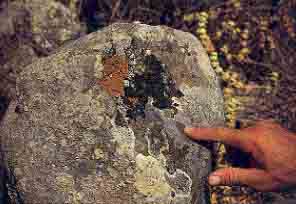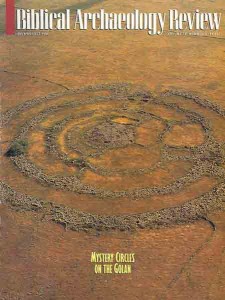More Than Moss: Dating Structures by Lichen Growth
Sidebar to: Mystery Circles

Studying lichens—the common plants that are part algae and part fungi that we know as a scaly adherence on rock surfaces—was perhaps the most unusual approach used at Rogem Hiri to distinguish original construction from structures built later. Other methods, such as studying structural relations between walls and observing interruptions in the weathering patterns on the stone, are more familiar.
The science of lichenometry—the study of lichen cover patterns, colonization and growth—is based on the slow growth rate of lichens on exposed surfaces and the long life expectancy of many of their colonies. In certain habitats, lichens may reach their final size only after several thousand years.
Although lichenometry is far less accurate than carbon-14 dating or dendrochronology (dating by studying growth rings in trees), it is useful for estimating dates within a range of several hundred years. Lichenometry can also provide relative dates such as which walls were built first. Determining a specific date by lichenometry requires comparison of growth patterns at a site with growth patterns at other sites in the region whose dates are known by more precise, independent means, such as by carbon-14, coins or inscriptions.
Lichenometry has been used as a dating technique at many archaeological sites, mostly outside the Near East. It showed that the huge stone monuments on Easter Island had existed for at least 800 years and helped detect the movement of stones in two Neolithic stone circles in England.
Already a library member? Log in here.
Institution user? Log in with your IP address.

